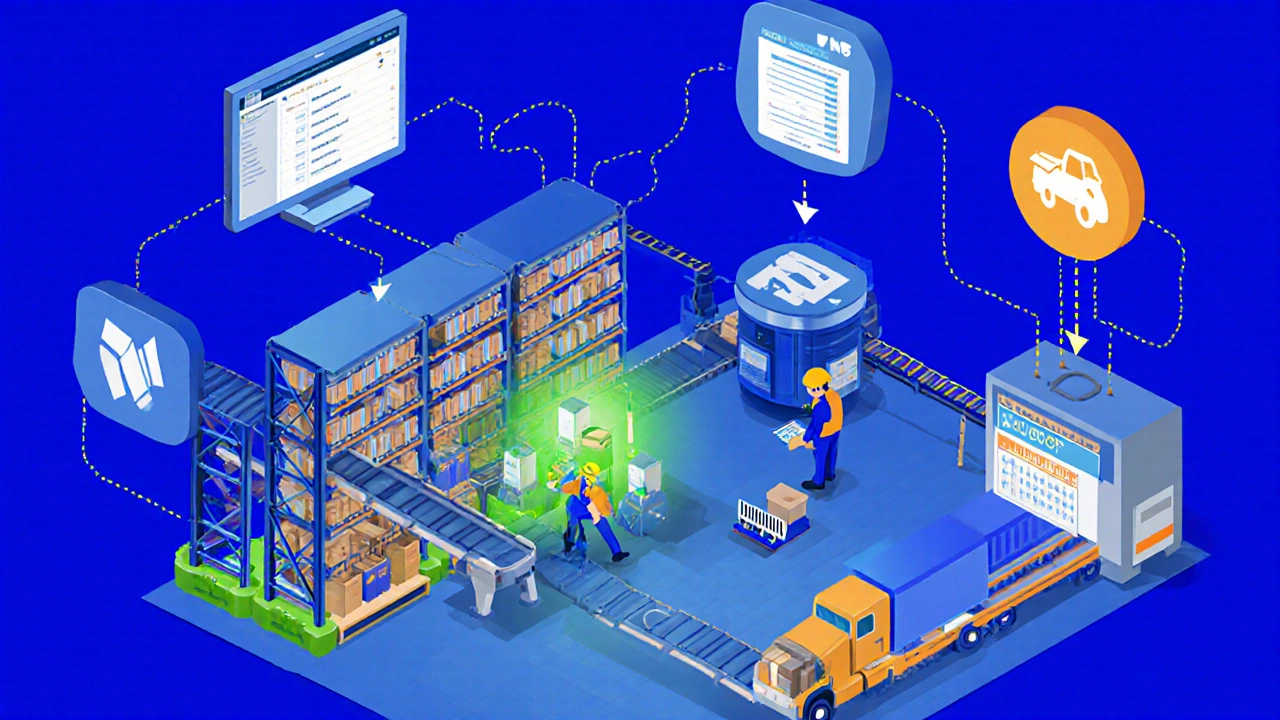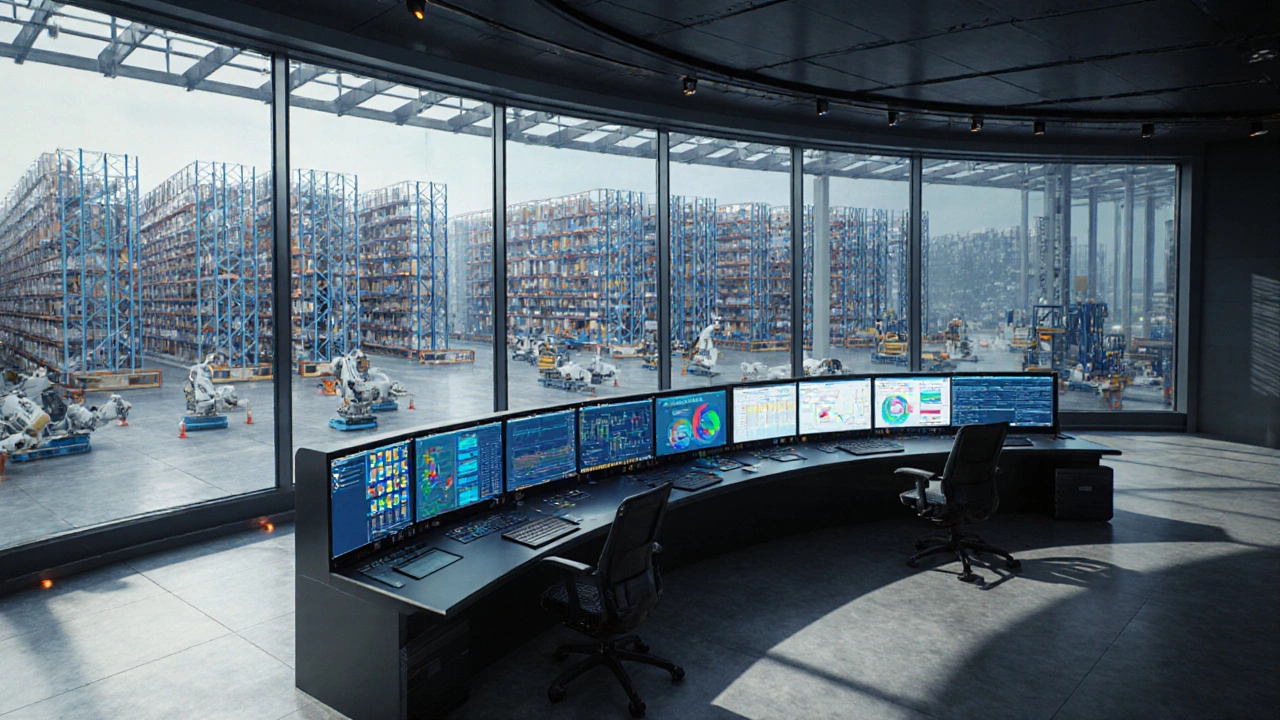Warehouse Software Selection Advisor
Your Recommended Solution
Select your business profile to get recommendations
Key Takeaways
- Warehouse Management Software (WMS) is the backbone of modern warehouse operations.
- Complementary systems - IMS, OMS, LMS, TMS, YMS - address specific workflow needs.
- Cloud‑based WMS options have become the default for scalability and lower upfront cost.
- Choosing the right solution starts with mapping your processes and growth plans.
- Successful implementation hinges on data clean‑up, staff training, and phased roll‑out.
When it comes to modern storage facilities, Warehouse Management Software (WMS) is the core system that coordinates inventory, labor, and order fulfillment in real time. If you’re wondering warehouse software that powers a typical distribution center, you’ll quickly discover a family of specialized tools that talk to each other. Below we break down each major type, spotlight leading vendors, and give you a practical checklist to pick the right stack for your business.
1. Core Types of Warehouse Software
Think of a warehouse as a small city. The WMS is the city hall, but you still need traffic control, public services, and utilities. Here’s how the ecosystem fits together:
- Inventory Management System (IMS) - tracks stock levels, locations, and lot/serial numbers down to the pallet.
- Order Management System (OMS) - receives sales orders from e‑commerce platforms or ERP, then tells the WMS what to pick.
- Labor Management System (LMS) - schedules workers, measures productivity, and assigns tasks based on skill.
- Transportation Management System (TMS) - plans inbound/outbound freight, routes drivers, and optimises load planning.
- Yard Management System (YMS) - monitors dock doors, trailers, and yard trucks to avoid bottlenecks.
- Warehouse Automation Software - controls robots, conveyors, and pick‑to‑light devices.
- ERP Integration Layer - ensures financial, procurement, and sales data flow seamlessly between the WMS and the broader enterprise system.
Every modern WMS includes a built‑in IMS, but most larger operations layer on the other modules as separate, tightly integrated applications.
2. How the Pieces Interact - A Real‑World Example
Imagine a UK‑based retailer that sells home goods online. A customer places an order on the website, which pushes the data to the retailer’s NetSuite ERP. NetSuite’s OMS creates a pick list and sends it to the WMS. The WMS tells the LMS which workers should handle the pick, while the automation software directs a pick‑to‑light device to the exact shelf. Once the items are scanned, the WMS updates the IMS, notifies the TMS to arrange a carrier, and the YMS checks dock availability. All these actions are recorded in the ERP for invoicing and reporting.

3. Leading Vendors in 2025
Below is a snapshot of the most widely adopted solutions, covering everything from tiny third‑party logistics (3PL) firms to Fortune 500 distributors.
| Vendor | Core Features | Deployment | Typical Business Size | Pricing Model |
|---|---|---|---|---|
| Manhattan Associates | Advanced slotting, AI‑driven demand forecasting, multi‑modal TMS | Cloud & On‑prem | Mid‑market to enterprise | Subscription per pallet‑slot |
| SAP Extended Warehouse Management (EWM) | Deep ERP integration, labor optimization, robotics support | On‑prem & Cloud (SAP S/4HANA) | Large enterprises | License + annual maintenance |
| Oracle Warehouse Management Cloud | Real‑time inventory visibility, voice picking, IoT sensor integration | Cloud‑only | Mid‑market to enterprise | Usage‑based subscription |
| Fishbowl Inventory | Simple IMS, barcode scanning, QuickBooks sync | On‑prem (hosted optional) | SMBs & startups | One‑time license + optional support |
| NetSuite WMS | Native ERP link, cloud UI, mobile wave picking | Cloud‑only | SMBs growing to mid‑market | Tiered subscription per user |
4. Choosing the Right Stack for Your Warehouse
There’s no one‑size‑fits‑all answer, but the following decision framework helps you narrow down the field:
- Map Your Process Gaps. List every step from receiving to shipping. Identify where you lose time or make errors - perhaps you have no labor scheduling tool or your pick accuracy sits at 93%.
- Define Scale and Growth. How many SKUs do you manage today? What’s the projected growth over the next three years? Cloud solutions scale gracefully; on‑prem may require extra hardware later.
- Check Integration Requirements. Does the warehouse need to sync with a specific ERP (SAP, Microsoft Dynamics, QuickBooks) or an e‑commerce platform (Shopify, Magento)? Look for native connectors or robust APIs.
- Assess Deployment Costs. Add up license fees, implementation consulting, hardware (RF scanners, barcode printers), and ongoing support. Remember that a lower upfront price can hide high customisation fees later.
- Pilot Before Full Roll‑Out. Run a 30‑day proof of concept on a single aisle or product line. Measure KPIs such as pick‑to‑ship time, inventory accuracy, and labor utilisation.
When you answer these questions, you’ll quickly see whether a turnkey cloud WMS (e.g., NetSuite) or a modular on‑prem suite (e.g., SAP EWM) aligns with your budget and timeline.
5. Common Pitfalls and How to Avoid Them
- Skipping Data Clean‑Up. Uploading legacy Excel sheets into a new WMS creates ghost SKUs and duplicate locations. Conduct a data audit and standardise naming conventions first.
- Under‑estimating Change Management. Workers resist new handheld devices unless you involve them early. Run hands‑on training sessions and reward adoption milestones.
- Choosing Feature Over Fit. A system packed with AI‑driven slotting is impressive, but if your warehouse only handles a few hundred SKUs, you’ll pay for unused horsepower.
- Ignoring Mobile Compatibility. Modern pickers rely on Android/iOS tablets. Verify that the WMS UI is responsive and works offline when Wi‑Fi drops.
- Failing to Plan for Integration. Treat the WMS as a silo and you’ll double‑enter data. Map data flows (order → OMS → WMS → TMS) and use middleware if native APIs are missing.

6. Implementation Roadmap - From Selection to Go‑Live
A structured rollout keeps disruption to a minimum. Follow this six‑step timeline:
- Project Kick‑off. Assemble a cross‑functional team - warehouse manager, IT lead, finance, and a senior picker as the user champion.
- Requirements Workshop. Capture functional specs (e.g., wave picking, cross‑dock) and non‑functional needs (response time < 2 seconds, 99.9% uptime).
- Vendor Demo & Selection. Use a scoring matrix (features, cost, support SLA). Record scores in a shared spreadsheet for transparency.
- Configuration & Integration. Set up master data (locations, bins, users). Connect the WMS API to your ERP and TMS, and test with a sandbox.
- Pilot Test. Run a live test on a single receiving dock for two weeks. Capture KPI changes and gather user feedback.
- Full Scale Go‑Live. Roll out in phases (receiving → put‑away → picking → shipping). Maintain a hyper‑care support desk for the first 30 days.
Document every step in a project log; it becomes invaluable when you need to troubleshoot later.
7. Future Trends Shaping Warehouse Software
Even if you’re only planning today, keep an eye on emerging capabilities:
- AI‑Driven Predictive Slotting. Machine learning models analyse order history to place fast‑moving SKUs in the most reachable spots, cutting travel time by up to 15%.
- Digital Twin Simulations. Virtual replicas of the warehouse let you test layout changes before moving racks.
- Edge Computing for IoT Sensors. Real‑time temperature and humidity monitoring at the pallet level improves cold‑chain compliance.
- Voice‑First Picking. Hands‑free headsets integrated with WMS reduce error rates below 0.3% for large‐scale pick lines.
Choosing a platform that supports APIs and modular extensions will let you adopt these innovations without a full replacement.
Frequently Asked Questions
What is the difference between a WMS and an ERP?
A WMS focuses on the day‑to‑day movement of goods inside the warehouse - receiving, put‑away, picking, and shipping. An ERP (Enterprise Resource Planning) covers the whole business, including finance, procurement, HR, and sales. The WMS often plugs into the ERP so that inventory updates flow to accounting and order status reflects in the sales system.
Do I need separate software for inventory and order management?
Many modern WMS platforms bundle both inventory and order capabilities. However, companies with complex B2B ordering rules sometimes keep a dedicated OMS to handle contract pricing, bulk order approvals, and split shipments.
Is cloud‑based WMS affordable for a small warehouse?
Yes. Cloud subscriptions typically charge per active user or per pallet slot, so a three‑person operation can start with a few hundred pounds a month. The biggest savings come from avoiding server hardware and the IT staff needed to maintain it.
How long does a typical WMS implementation take?
For a cloud solution with standard modules, 8-12 weeks is common. On‑premise or heavily customised projects can stretch to 6 months or more, especially if you need extensive integration with legacy ERP.
Can I integrate a WMS with existing barcode scanners?
Almost all WMS products support standard 1D and 2D barcode formats over USB, Bluetooth, or Wi‑Fi. Check the vendor’s hardware compatibility list before buying new scanners.


